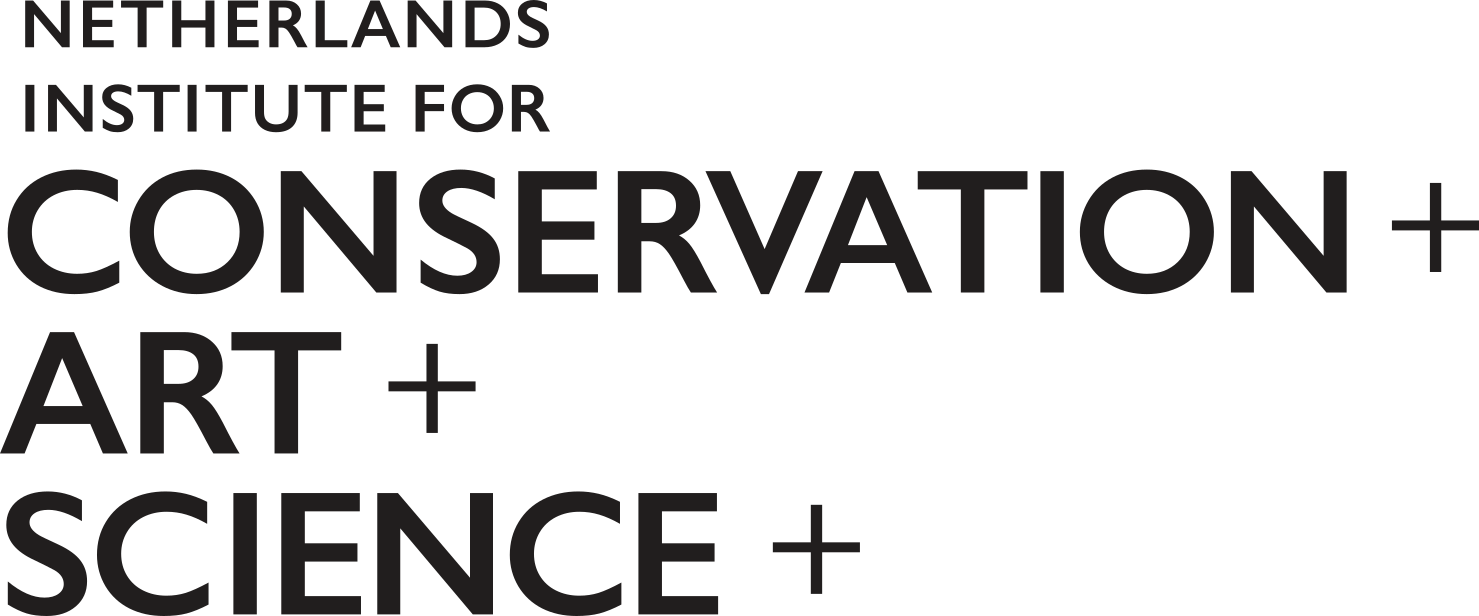Media
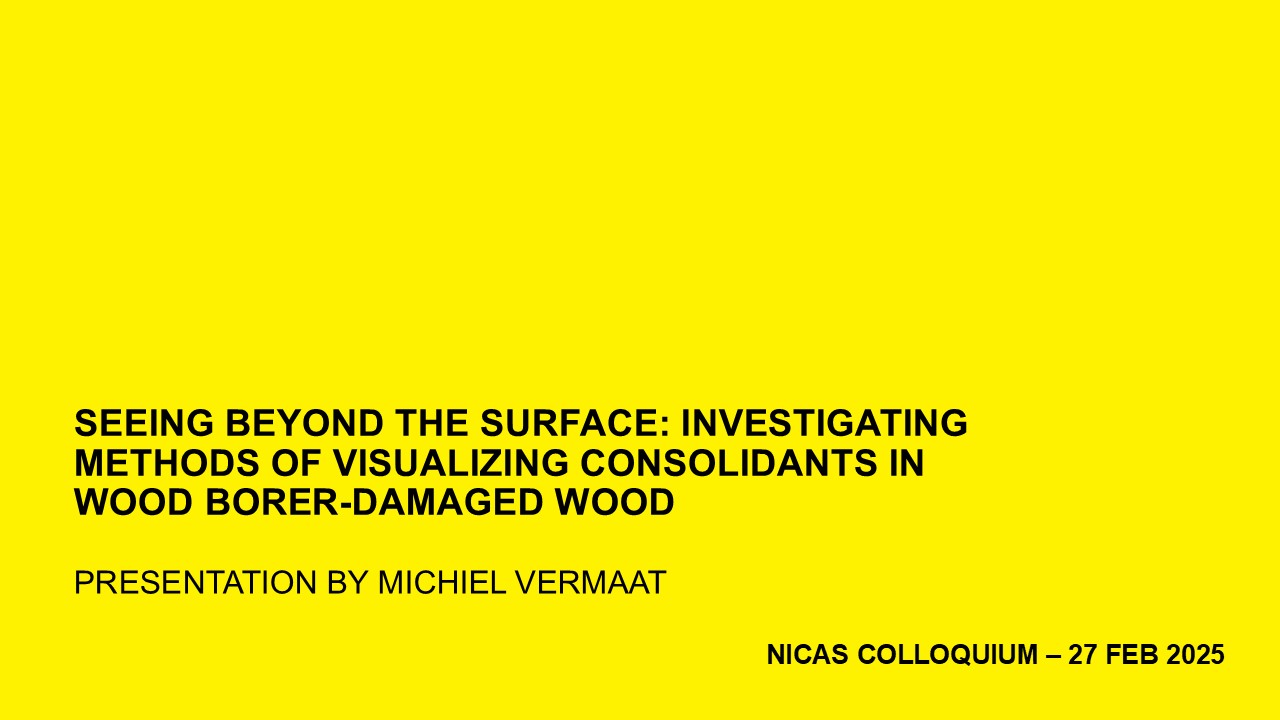
NICAS Colloquium
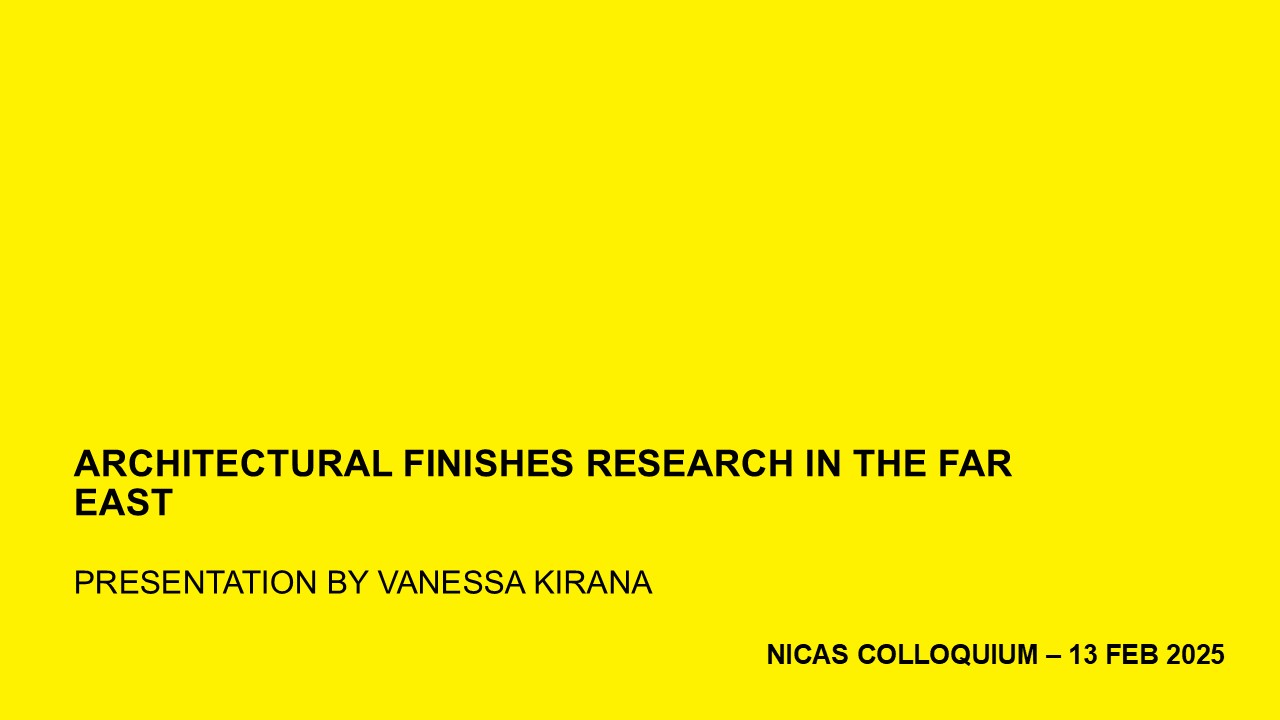
NICAS Colloquium
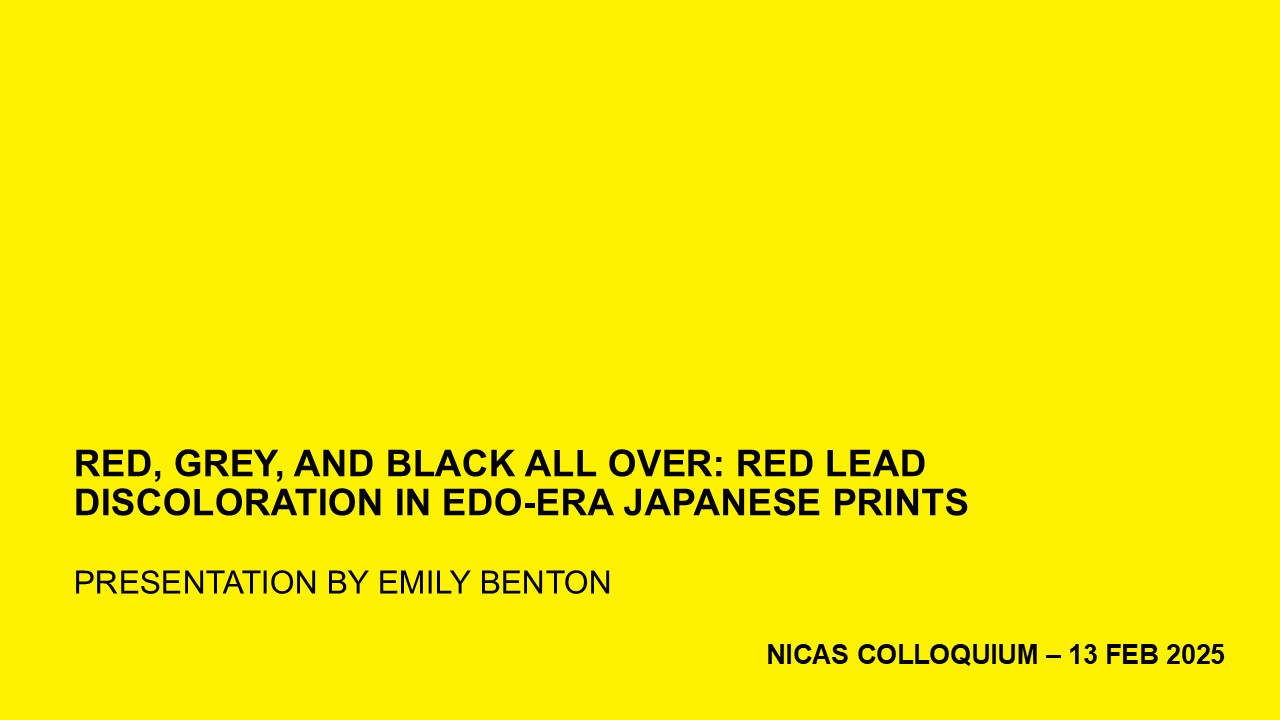
NICAS Colloquium
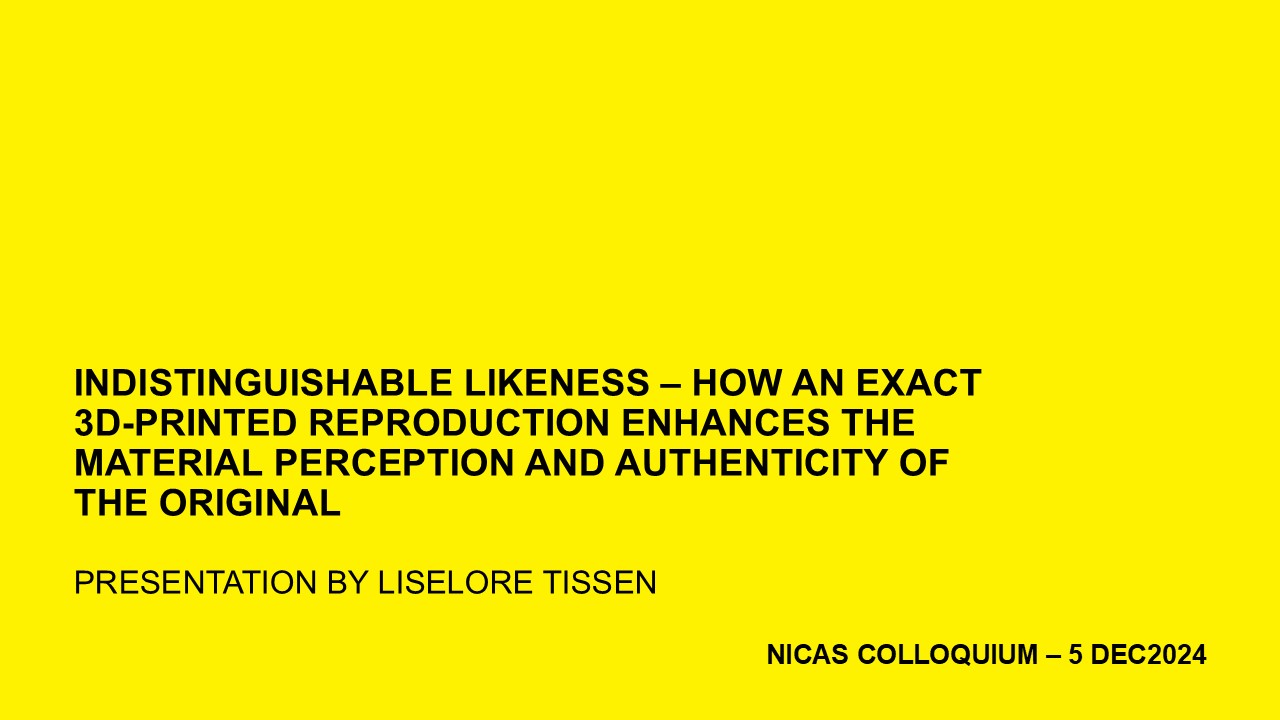
NICAS Colloquium
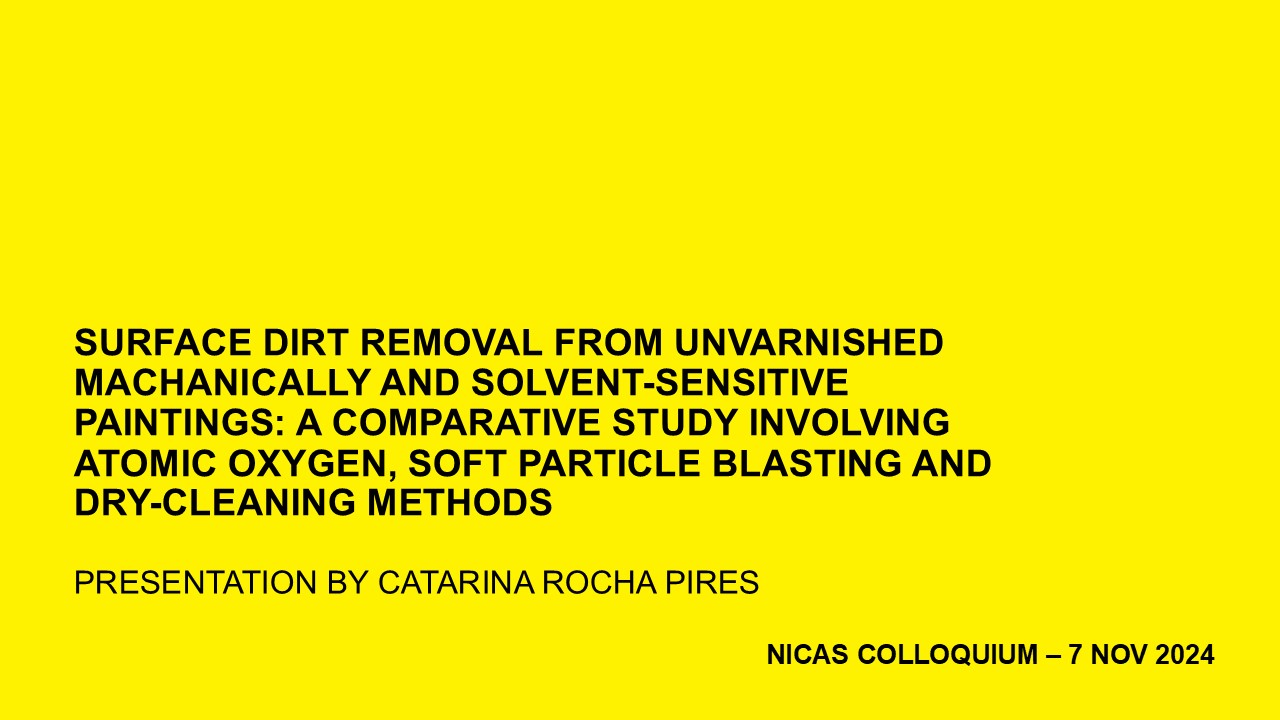
NICAS Colloquium
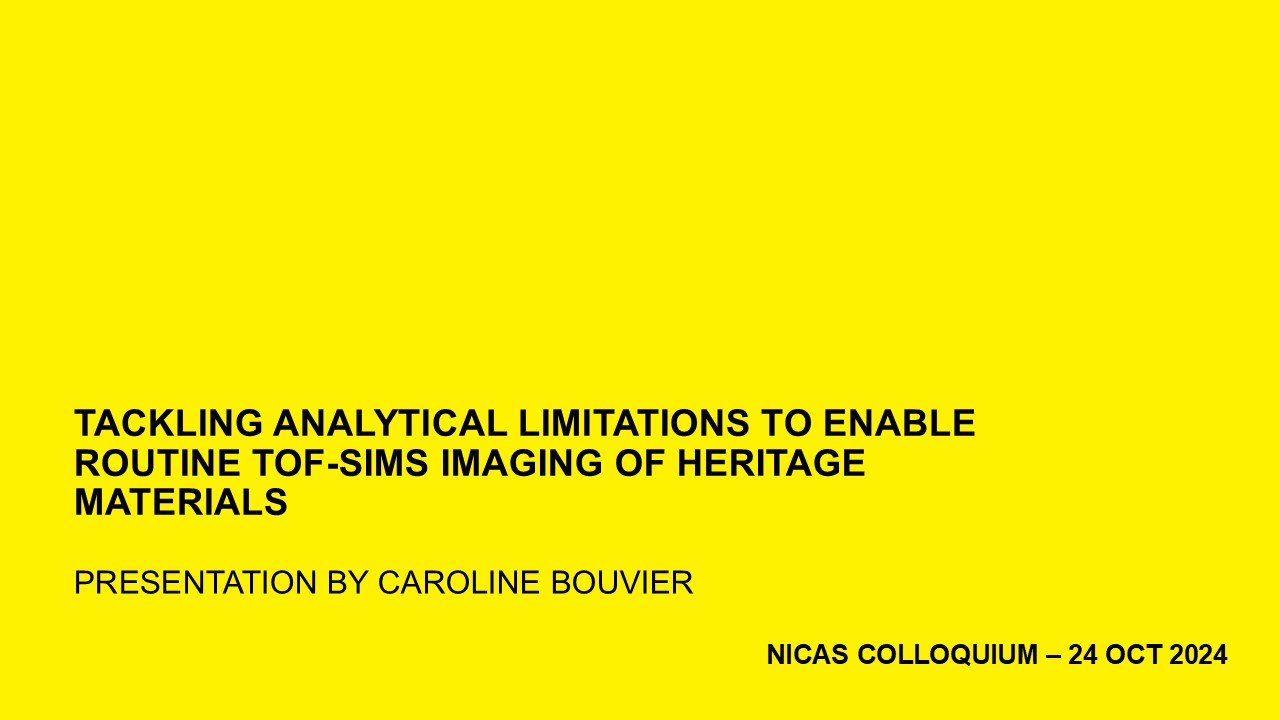
NICAS Colloquium
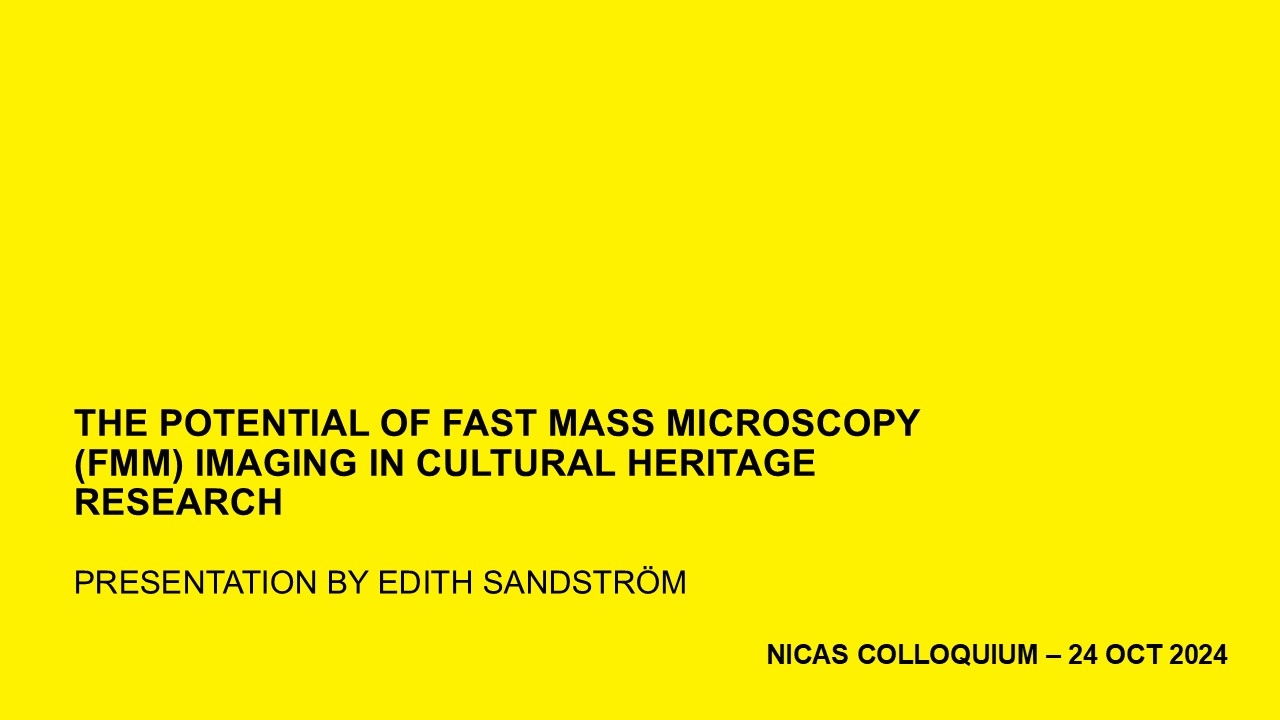
NICAS Colloquium
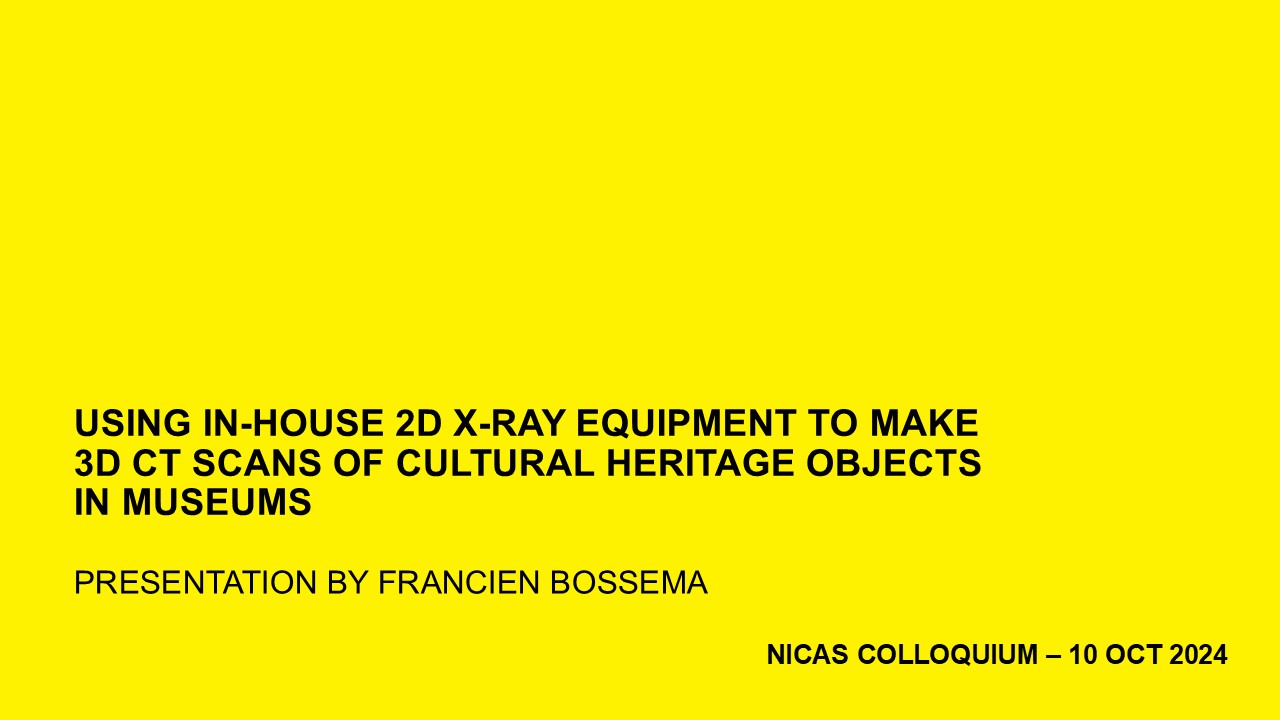
NICAS Colloquium
-
NICAS Colloquium
► Michiel Vermaat – ‘Seeing Beyond the Surface: Investigating Methods of Visualizing Consolidants in Wood Borer-Damaged Wood’. This research investigates imaging methods for visualizing consolidants in wood borer-damaged polychrome sculpture to improve preservation techniques. X-ray imaging, X-ray computed tomography (CT), and thermal neutron CT were tested for their ability to detect frequently used consolidants and experimental consolidant formulations containing zinc oxide (ZnO) nanoparticles in heavily wood borer-damaged wooden samples.Traditional imaging methods struggled to directly visualize consolidants due to low contrast with the wood matrix. However, ZnO nanoparticle-enhanced consolidants were successfully detected using X-ray and CT, providing indirect evidence of consolidant penetration and distribution. Thermal neutron CT faced similar contrast limitations. To further analyze the distribution of ZnO nanoparticle-loaded consolidants, Blender was used to create 3D reconstructions from imaging data. This enabled clearer visualization of consolidant flow within the wood structure. The study highlights the potential of ZnO nanoparticles as contrast agents and the value of digital reconstructions in heritage conservation research. Michiel Vermaat recently completed a master’s degree in Conservation and Restoration of Cultural Heritage at the University of Amsterdam. His primary interest lies in overcoming the challenges of assessing the effectiveness of consolidating wood borer-degraded wooden objects. This article is based on his thesis, which explored the use of X-ray imaging, X-ray CT, and thermal neutron CT to visualize the effectiveness of consolidants in damaged wood. Michiel aims to pursue a career in conservation or continue research in applied restoration techniques. -
NICAS Colloquium
► Vanessa Kirana – Architectural Finishes Research in the Far East The master’s thesis, completed in 2024, utilised the Architectural Finishes Research (AFR) methodology practised in the Netherlands to gain insights into historical architectural practices in Singapore. This research focused on the influences that shaped local building methods and centred on a shophouse built in 1921, referred to as Midfilm House. By the 20th century, Singapore was a key British trading port on the Malaya Peninsula and underwent significant architectural transformations. Shophouses, recognised for their cost-efficiency and dual-purpose design for commerce and residence, became a dominant architectural form. Midfilm House’s eclectic architectural style incorporated Western classical elements alongside Indo-Islamic motifs. The AFR findings revealed how the diffusion of distinct cultures was also embodied in its lime-based finishes. The application technique and materials constituents signified the effects of international trade and knowledge transfer within the expansive British Empire at the time. Vanessa Kirana graduated from a two-year master’s programme in Conservation and Restoration of Cultural Heritage from the University of Amsterdam (UvA), where she specialised in Historic Interiors. She is now continuing her studies in the Advanced Professional Programme to further her training as a conservator-restorer. Before starting her studies, she had four years of professional experience at Studio Lapis, an architectural conservation consultancy firm in Singapore. Her research interests centre on architectural finishes, particularly the influence and adaptation of finishes technology across continents. Additionally, she hopes to develop expertise in conserving polychrome surfaces on substrates ranging from plaster to wood -
NICAS Colloquium
► Emily Benton – Red, Grey, and Black All Over: Red Lead Discoloration in Edo-Era Japanese Prints Japanese woodblock prints produced during the Edo period (1603 – 1868) use red lead (Pb3O4) as a pigment. Red lead is known to discolor to black, brown, and silver. Prints from the collection of the Rijksmuseum which were suspected of containing this pigment and were discolored were examined. A reconstruction and analysis were also carried out to identify the source of the discoloration. The reconstructed samples were aged using H2S from boiled eggs. Analysis confirmed the existence of red lead on the Rijksmuseum prints, but the identity of the degradation products could not be determined. The discoloration is suspected to be plattnerite (PbO2) or lead sulfide (PbS). During the reconstruction, it was found that the ratio of red lead to PbO significantly affected how and the amount the samples discolored. Samples containing more PbO discolored quickly and formed a silvery discoloration, while samples with more Pb3O4 discolored slowly and turned brown-black. Emily Benton currently a student at the University of Amsterdam studying Book and Paper conservation under the Advanced Professional Programme. Previously she has received a master’s degree in the Conservation and Restoration of Cultural Heritage at the University of Amsterdam. For her master’s thesis she has researched the discoloration of red lead in ukiyo-e prints and how the preparation of materials and printing process effects how said discoloration forms. -
NICAS Colloquium
►Liselore Tissen – Indistinguishable likeness – How an exact 3D-printed reproduction enhances the material perception and authenticity of the original Abstract: As technology advances, we now have the possibility to create reproductions of paintings that are indistinguishable from their original with 3D printing. Moreover, due to its digital nature, we can alter, tweak, and manipulate the highly detailed surface information and supplement it with data gathered with material analysis techniques commonly used in conservation and research. The fact that we can display a version of Girl with a Pearl Earring with every detail reconstructed to when Vermeer finished the painting in 1665 challenges or notion of authenticity and what is visible on the original’s canvas. In this presentation, Liselore Tissen will shed light on the way 3D printed reproductions and reconstructions of artworks can not only enhance our understanding of the original’s materials, change our interaction and reaction to art but also how it can democratize the discussions surrounding concepts such as authenticity and originality in a rapidly changing digital and cultural environment. Bio: Liselore Tissen is a postdoctoral researcher at Leiden University and Delft University of Technology and coordinator of communication, education, research, and ethics at the Royal Netherlands Academy of Arts and Sciences (KNAW) and Social Sciences and Humanities Open Cloud (SHHOC-NL). Her research focuses on the intersection of the humanities, social sciences, natural sciences, the arts, and technology. By integrating philosophical and ethical evaluations with field research and museum visitor studies, she explores the moral and practical implications of emerging technologies for the art field, contemporary artists, technical art historical research, conservation, and museum presentation. -
NICAS Colloquium
►Catarina Rocha Pires – Surface dirt removal from unvarnished mechanically and solvent-sensitive paintings: a comparative study involving atomic oxygen, soft particle blasting and dry cleaning methods Abstract: The presentation will share initial results of a comparative study on cleaning unvarnished paintings that are sensitive to mechanical and/or solvent-based methods. These delicate surfaces, including water-sensitive and porous oil paints and acrylics, require alternative cleaning techniques to prevent damage. Tested methods include atomic oxygen (AO) cleaning, soft particle blasting, and dry cleaning. AO cleaning, currently in development as part of the Horizon Europe MOXY project, offers a unique non-contact method. It uses reactive atomic oxygen to break down carbon-based contaminants into CO, CO₂, and H₂O vapours. This approach enables effective cleaning without solvents or direct contact with the surface. The experiments included soot and an artificial soil which were applied to both water-sensitive and highly porous paint mock-ups. Assessments were made through visual observation, digital microscopy, SEM-EDX analysis, and colour and gloss measurements. AO cleaning proved highly effective on porous and oil-based surfaces, dry cleaning effectively removed soot from water-sensitive paints, and soft particle blasting showed promise for embedded soiling on acrylics. The work to be presented was developed in close collaboration with three master’s students, from the University of Amsterdam and the Courtauld Institute of Art (London). Bio: Catarina Rocha Pires is a PhD candidate at the University of Amsterdam, part of the Horizon Europe MOXY project, supervised by Prof. Dr. Klaas Jan van den Berg and Dr. Emilie Froment. She holds both a bachelor’s and a master’s degree in Conservation and Restoration from the NOVA School of Science and Technology in Lisbon, Portugal. Before beginning her PhD, Catarina gained practical experience in conservation and restoration and conservation science through internships at the Cultural Heritage Agency of the Netherlands (RCE) in Amsterdam, SRAL The Conservation Institute in Maastricht, and several museums in Lisbon. -
NICAS Colloquium
► Caroline Bouvier – Tackling analytical limitations to enable routine ToF-SIMS imaging of heritage materials Abstract: Heterogeneous organic-inorganic microstructures in heritage materials can be investigated with mass spectrometry imaging techniques, such as Time-of-Flight Secondary Ion Mass Spectrometry (ToF-SIMS). Its asset is the simultaneous sub-micrometer mapping of both organic and mineral materials on a micro-sample. Past studies highlighted its potential and limiting factors. The SCIMITAR project combines a well-documented set of reference materials from several partners with the opportunity to dedicate time to exploring the instrument’s capabilities. Example of improvements of the technique’s suitability for heritage research questions include reducing signal distortions observed on insulating samples with cost-effective solutions, enabling optimized analysis of resin-embedded sample. It also consists in fostering data processing by sharing all new marker ions identified during the project in an open access peer reviewed database, to allow for unambiguous identification of given compounds. Bio: Caroline Bouvier obtained her PhD in 2022 at Sorbonne University on the application of ToF-SIMS imaging to heritage samples and the construction of a spectral database of pigments and binders. She then joined the scientific laboratory of the Bibliothèque nationale de France to work on the collaborative project ESPyON focusing on elastomers identification in collections. At the end of 2023, she joined M4i at Maastricht University as a postdoctoral fellow to work on the SCIMITAR project which aims to improve ToF-SIMS imaging’s capabilities for the identification of organic materials, specifically proteins, and to foster its accessibility for heritage research. -
NICAS Colloquium
► Edith Sandström – The potential of fast mass microscopy (FMM) imaging in cultural heritage research Abstract: Mass spectrometry imaging (MSI) is an analytical technique with increasing application in the field of cultural heritage. Most MSI analyses are conducted in the so-called microprobe mode, where a mass spectrum is collected for each pixel to create a mass image. This puts a practical limit on the spatial resolution used or possible sample area investigated, as doubling either of those parameters results in a quadrupling in analysis time. In contrast to microprobe mode, fast mass microscopy (FMM) is a recently developed microscope mode MSI technique, which decouples pixel size from scan rate, enabling much faster imaging at high spatial resolution. Recent improvements have made it possible to analyse an area equivalent to the unfrosted area of a microscope slide (42.5 × 26 mm2) at 1 µm in just below 4.5 min. In comparison, this same analysis would take almost 128 days of active analysis for microprobe mode MSI techniques. These characteristics of FMM analysis means that the molecular information of entire small objects, such as jewellery pieces or miniatures, could in the future be collected in a fraction of the time compared to other MSI techniques, aiding our global understanding of these objects, and directing further research. Bio: Edith Sandström obtained her PhD in 2023 at the University of Edinburgh, working with National Museums Scotland. Her work focused on the development of less to non-invasive chromatographic and mass spectrometric methods for the analysis of historical dyestuffs. This included the introduction of a small-scale sample preparation workflow for chromatographic investigations, and the building and application of a DESI source for mass spectrometry analysis of historical textiles. Currently, she is a postdoctoral researcher at M4i, Maastricht University, working on developing advanced mass spectrometric imaging techniques, including fast mass microscopy, for application in fields ranging from biomedical to heritage science. -
NICAS Colloquium
► Francien Bossema – Using in-house 2D X-ray equipment to make 3D CT scans of cultural heritage objects in museums. Abstract: A powerful technique for exposing the interior of museum objects is computed tomography (CT). However, the lack of affordable and versatile CT equipment in museums, combined with the challenge of transporting precious collection objects, currently keeps this technique out of reach for most cultural heritage applications. We propose an approach for creating accurate CT reconstructions using only standard 2D radiography equipment already available in most larger museums. Specifically, we demonstrate that a combination of basic X-ray imaging equipment, a tailored marker-based image acquisition protocol, and sophisticated data-processing algorithms, can achieve 3D imaging of collection objects without the need for a costly CT imaging system. We implemented this approach in the British Museum (London), the J. Paul Getty Museum (Los Angeles), and the Rijksmuseum (Amsterdam). Our work paves the way for broad facilitation and adoption of CT technology across museums worldwide and was recently published in Nature Communications. Bio: Francien Bossema obtained her master’s degree in Mathematics, with an additional specialisation in Science Communication & Society from Leiden University, The Netherlands. In 2024 she obtained her Ph.D. degree at the national research institute for mathematics and computer science (CWI) in Amsterdam, The Netherlands, in collaboration with the Rijksmuseum, Amsterdam, on the topic of ‘Tailoring X-ray tomography techniques for cultural heritage research’. Part of her research was performed at the British Museum (London, UK). During her Ph.D. she published four peer-reviewed first author articles, amongst others in Scientific Reports and Nature Communications. She is currently engaged as postdoctoral fellow at the Rijksmuseum, Amsterdam and as postdoctoral researcher at the Centrum Wiskunde & Informatica. Last summer, she was at the J. Paul Getty Museum in Los Angeles, USA, for a Museum Guest Scholarship. More information, such as a list of publications, presentations, blogs and videos, can be found here: fgbossema.github.io.
